loading...
- No. 9, Xingyuan South Street, Dongwaihuan Road, Zaoqiang County, Hengshui, Hebei, China
- admin@zjcomposites.com
- +86 15097380338
- Welcome to visit our website!
Innovative Solutions for Strength and Flexibility in FRP Rod Applications
The Versatility of FRP Rods Revolutionizing Modern Construction and Engineering
Fiber Reinforced Polymer (FRP) rods are increasingly becoming a vital component in various sectors of construction and engineering. Comprising a polymer matrix reinforced with strong fibers—typically carbon, glass, or aramid—FRP rods are gaining popularity due to their unique properties such as lightweight, corrosion resistance, and high tensile strength. These attributes position FRP rods as a superior alternative to traditional materials, like steel, in many applications.
One of the most significant advantages of FRP rods is their remarkable resistance to corrosion. Unlike steel, which is prone to rust and degradation in harsh environments, FRP rods maintain their structural integrity even in chemically aggressive settings. This quality makes them an ideal choice for use in marine environments, wastewater treatment plants, and other facilities where exposure to corrosive substances is a concern. As a result, infrastructure projects utilizing FRP rods typically have extended lifecycles, reducing maintenance costs and enhancing safety.
.
In terms of thermal properties, FRP rods also offer benefits. They have low thermal conductivity, which helps to mitigate issues related to temperature fluctuations. This is especially beneficial in applications like bridge construction, where temperature-induced expansion and contraction can lead to structural stress. By using FRP rods, engineers can ensure that their designs are more resilient and less prone to damage over time.
frp rod

Another exciting aspect of FRP rods is their environmental impact. Companies are increasingly prioritizing sustainability in their operations, and the use of FRP materials aligns with these goals. FRP rods can be produced using eco-friendly processes, and their longevity means less frequent replacements, reducing waste over time. Additionally, many FRP products can be recycled, further contributing to their environmentally friendly profile.
Beyond construction, FRP rods have gained traction in numerous other fields, including automotive and aerospace industries. In these sectors, the demand for lightweight, high-strength materials is paramount. FRP rods can be utilized in manufacturing components that require both performance and efficiency, aiding in the production of vehicles that consume less fuel and have a smaller carbon footprint.
As technology continues to advance, the potential applications for FRP rods seem virtually limitless. Innovative research is ongoing, with engineers exploring ways to enhance the properties of FRP materials further and expand their use in various industries.
In conclusion, FRP rods represent a significant evolution in materials science and engineering. With their combination of strength, lightweight construction, corrosion resistance, and sustainability, they are paving the way for more resilient and environmentally friendly infrastructure and products. As construction and engineering challenges continue to evolve, FRP rods will undoubtedly play a crucial role in shaping the future of these industries.
-
The Rise of FRP Profiles: Strong, Lightweight, and Built to LastNewsJul.14,2025
-
SMC Panel Tanks: A Modern Water Storage Solution for All EnvironmentsNewsJul.14,2025
-
GRP Grating: A Modern Solution for Safe and Durable Access SystemsNewsJul.14,2025
-
Galvanized Steel Water Tanks: Durable, Reliable, and Ready for UseNewsJul.14,2025
-
FRP Mini Mesh Grating: The Safer, Smarter Flooring SolutionNewsJul.14,2025
-
Exploring FRP Vessels: Durable Solutions for Modern Fluid HandlingNewsJul.14,2025
-
GRP Structures: The Future of Lightweight, High-Performance EngineeringNewsJun.20,2025
